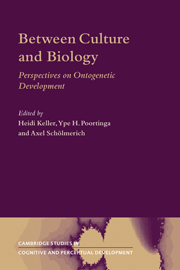Book contents
- Frontmatter
- Contents
- List of figures
- List of tables
- Notes on contributors
- Acknowledgements
- Introduction
- Part I Setting the scene
- Part II Perspectives on development informed by culture
- Part III Perspectives on development drawing from the universal and the specific
- 8 Between individuals and culture: individuals' evaluations of exclusion from social groups
- 9 Biology, culture and child rearing: the development of social motives
- Part IV Perspectives on development informed by evolutionary thinking
- Part V Metaperspectives
- Author index
- Subject index
- Cambridge Cultural Social Studies
9 - Biology, culture and child rearing: the development of social motives
Published online by Cambridge University Press: 22 September 2009
- Frontmatter
- Contents
- List of figures
- List of tables
- Notes on contributors
- Acknowledgements
- Introduction
- Part I Setting the scene
- Part II Perspectives on development informed by culture
- Part III Perspectives on development drawing from the universal and the specific
- 8 Between individuals and culture: individuals' evaluations of exclusion from social groups
- 9 Biology, culture and child rearing: the development of social motives
- Part IV Perspectives on development informed by evolutionary thinking
- Part V Metaperspectives
- Author index
- Subject index
- Cambridge Cultural Social Studies
Summary
Traditionally, culture and biology are two quite distant research areas with different research traditions, different methods, rooted in different theoretical frames of reference. For a long time culture was often seen as too complex to be studied in the nomological way by ‘hard’ psychological methods. Cross-cultural psychologists accordingly have used culture mainly to enlarge the range of variance in the phenomena they studied. For cultural psychologists, on the other hand (Boesch, 1991; Eckensberger, 1990), the importance of culture consists the uniqueness of meanings, beliefs and symbols in a particular culture. Therefore hermeneutic and ideographic approaches seem appropriate. However, the awareness concerning cultural influences has increased in psychology over the last decades.
Biology as a natural science is traditionally seen as a strict nomological science, with methods and findings rooted in physics and chemistry. Therefore biology seems to be rather distant from human behaviour and especially culture. Yet, the more we know about genetics and neurophysiological processes, the more psychology tends to become a ‘neural’ science, while traditional, pure psychological methods and theories seem to become more and more marginal.
In this chapter, the term culture refers mainly to a stored meaning system, effective for socialization and child rearing beliefs. In contrast, biology provides the neurophysiological and endocrinological underpinnings of behaviour. Yet, is necessary to integrate both conceptions (Plomin and Rutter, 1998; Belsky, Steinberg and Draper, 1991), which will be attempted for the development of social motives in this chapter.
- Type
- Chapter
- Information
- Between Culture and BiologyPerspectives on Ontogenetic Development, pp. 191 - 212Publisher: Cambridge University PressPrint publication year: 2002
- 5
- Cited by

